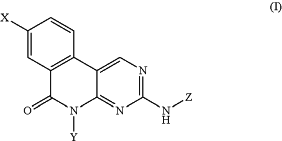| CPC A61K 31/4545 (2013.01) [A61K 31/519 (2013.01); C07D 471/04 (2013.01); C07D 519/00 (2013.01)] | 20 Claims |
|
1. A compound having the structure formula (I):
 or a pharmaceutically acceptable salt, or N-oxide thereof, or a solvate or hydrate thereof, wherein
X is hydrogen, Cak(C0-C6alkyl), Hca(C0-C6alkyl), Ar(C0-C6alkyl), Het(C0-C6alkyl), halogen or Hca(C1-C6alkyl)-O—, wherein Ar, Het, Cak, Hca and the alkyl group is optionally substituted by one to four —RX1 groups, wherein each —RX1 is independently halogen, cyano, C1-C6alkyl, C1-C6haloalkyl, —C1-C6alkoxy, oxo, —OR, —SR, —NR2, —C(O)R, —C(O)OR, —C(O)NR2, —S(O)2NR2, —S(O)2R, —OC(O)R, —N(R)C(O)R, —OC(O)OR, —OC(O)NR2, —N(R)C(O)OR, —N(R)C(O)NR2, —N(R)S(O)2R, OP(O)(OR)2, —CH2—OP(O)(OR), Ar(C0-C6alkyl), Het(C0-C6alkyl), Cak(C0-C6alkyl) or Hca(C0-C6alkyl), or two —RX1 groups taken together, when attached to adjacent atoms, form a Cak, Hca or Het, wherein the Cak Hca and the Het comprise a 3-8 membered ring optionally substituted with one or two —RX2 groups,
or two —RX1 groups taken together, when attached to the same carbon atom, form a Hca, wherein the Hca comprises a 3-8 membered ring optionally substituted with one or two —RX2 groups,
or two —RX1 groups taken together, when attached to non-adjacent atoms, and combined with X, form a bridged Hca optionally substituted with one or two —RX2 groups,
wherein each —RX2 is independently halogen, cyano, nitro, oxo, —OR, —SR, —NR2, —C(O)OR, —C(O)NR2, —C(O)R, —S(O)R, —S(O)2R, —S(O)OR, —S(O)2OR, —S(O)NR2, —S(O)2NR2, —OC(O)R, —OC(O)OR, —OC(O)NR2, —N(R)C(O)R, —N(R)C(O)OR, —N(R)C(O)NR2, —N(R)S(O)R, —N(R)S(O)2R, C1-C6alkyl, or C1-C6haloalkyl;
Y is Cak(C0-C8alkyl) or Hca(C0-C6alkyl), each optionally substituted by one or two —RY1 groups;
wherein each —RY1 is independently halogen, cyano, C1-C6alkyl, C1-C6haloalkyl, —C1-C6alkoxy, oxo, —OR, —SR, —NR2, N(R)C(NR2)NR2, —C(O)R, —C(O)OR, C(O)NR2, —S(O)2NR2, —S(O)2R, —OC(O)R, —N(R)C(O)R, —OC(O)OR, —OC(O)NR2, —N(R)C(O)OR, —N(R)C(O)NR2, —N(R)S(O)2R, —OP(O)(OR)2 or —CH2—OP(O)(OR);
Z is C1-C6alkyl substituted by one to three —RZ1 groups, or Z is Cak(C0-C6alkyl), optionally substituted by one to three —RZ1 groups;
wherein each —RZ1 is independently halogen, cyano, C1-C6haloalkyl, —C1-C6alkoxy, oxo, —OR, —SR, —NR2, —C(O)R, —C(O)OR, —C(O)NR2, —S(O)2NR2, —S(O)2R, —OC(O)R, —N(R)C(O)R, —OC(O)OR, —OC(O)NR2, —N(R)C(O)OR, —N(R)C(O)NR2, —N(R)S(O)2R, —OP(O)(OR)2 or —CH2—OP(O)(OR); and
each R is independently hydrogen, C1-C6alkyl, C1-C6haloalkyl, Hca(C0-C6alkyl), Cak(C0-C8alkyl), C1-C6alkyl-CN, —CH2C(O)NH2, C1-C6alkyl-OH, wherein
Hca is a 3-15 membered ring or ring system comprising at least one ring, 1-4 O, S, or N atoms, provided no O or S is adjacent to another O or S;
Het is a 5-15 membered aromatic ring or ring system comprising at least one ring and 1-4 O, S, or N atoms, provided no O or S is adjacent to another O or S;
Cak is a 3-8 membered non-aromatic carbocyclic ring or ring system, which may be saturated or partially unsaturated; and
Ar is a 6-16 membered aromatic ring or ring system having at least one carbocyclic aromatic ring optionally fused one or more aromatic or non-aromatic rings.
|